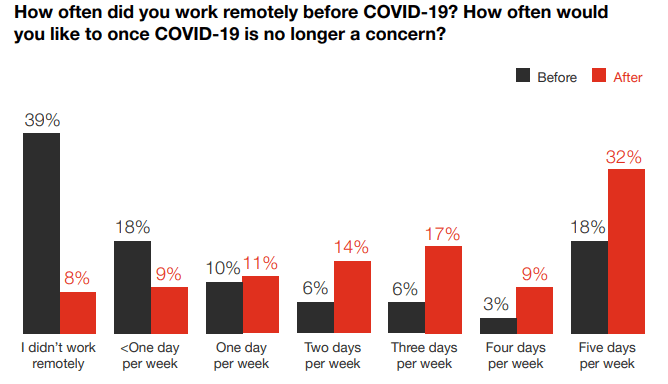Since the start of Covid-19, remote working has boomed across practically every industry that could facilitate it. And even though things are beginning to return to “normal,” both employers and workers seem hesitant to return to a full on-site workforce. In fact, according to a recent PwC pollopens PDF file , 83% of full-time employees who can work from home would choose to do so at least once per week after the pandemic, and 32% would want to work remotely full-time.

After all, plenty of advantages come with having a remote workforce. For employers, there are lower overhead costs, the ability to attract top talent from outside their geographical location, and reduced staff turnover. For employees, there’s greater work-life balance and flexibility, no commute, and the ability to take more control over their working schedule.
However, it can be difficult to keep remote employees engaged, motivated, and productive when there are no regular face-to-face interactions and no water cooler chats to be had.
Fortunately, you can use several strategies to help engage your remote employees more effectively, so you can keep productivity high while still reaping the benefits of having a remote workforce.
Define the roles and responsibilities of remote employees clearly
Ambiguity is the enemy of a productive remote team. With this in mind, clearly defining and documenting the roles and responsibilities of each remote team member is a key step in maintaining a cohesive, effective unit. Not only will this help to ensure that everyone knows what is expected of them, but it can also prevent overlap and duplication of effort.
Give remote employees the tools they need to be successful
Just because someone is working remotely doesn’t mean they should have to go it alone. Ensure your remote team has access to the same tools and resources as their office-based counterparts. This includes things like project management software, collaboration tools, and even financial planning resources. You also must ensure that everyone has the hardware they need to do their job, whether a laptop, smartphone, or external monitor. Nowadays, many companies offer an annual budget to remote workers that they can use to purchase any necessary equipment.
Set expectations and provide feedback regularly
Contrary to what many employers assume, workers want feedback. In fact, 92% of employees prefer feedback more often than once a year, and employees are three times more engaged when they receive daily input from their managers vs. an annual review. In light of this, employers must be ready to set expectations for their remote employees and provide feedback as often as possible.
After all, it can be easy for remote employees to feel disconnected from their work and their team when there is a lack of in-person meetings. Fortunately, there are several ways to provide feedback remotely, including video conferencing, instant messaging, and even email. However, it’s important to ensure that any feedback is given constructively, so it can be used to improve performance rather than demotivate employees.
Encourage them to be social and connect with other team members
Even though remote employees don’t work in the same physical space, that doesn’t mean they can’t socialize and connect with other team members. A study in the UK found that over half of employees (57%) said that having friends in the workplace makes their job more enjoyable, increasing their productivity and creativity.
To benefit from this, employers can encourage co-worker interaction by organizing social events (virtual or in-person), setting up dedicated chat rooms or forums for employees to socialize, and/or encouraging employees to connect with each other outside of work. The idea is to create opportunities for people to interact on a personal level so they feel more connected to each other and invested in the company as a whole. Not only is this one of the best ways to improve wellbeing for employees, but it can also lead to better teamwork, more creativity, and increased productivity.
Offer training and development opportunities
Employees who feel like they are constantly learning and growing are more engaged with their work. This is especially true for remote workers, who can feel isolated from their team and company if they’re not given the opportunity to develop their skills.
Fortunately, there are plenty of ways to offer training and development opportunities remotely. This could include anything from e-learning courses to webinars and virtual conferences. You can also provide access to online libraries, such as LinkedIn Learning or Skillshare, so employees can learn at their own pace. Don’t forget to encourage employees to share any new skills or knowledge they’ve acquired with the rest of the team, so everyone can benefit from their learning.
Celebrate their successes
Employees who feel like their successes are being celebrated are more engaged with their work. This is one of the easiest things for employers to do, yet so many fail to do it. Remember, this is different from formal feedback, and it should be given more frequently to show employees that their hard work is being noticed and appreciated.
There are many ways to celebrate an employee’s success, such as sending a handwritten note, giving them a paid day off, or even just sharing their successes with the rest of the team. Whatever you do, make sure it’s personalized and sincere, so the employee knows that their success is genuinely being celebrated.
Remote workers can feel especially disconnected from their team if they’re not given recognition for their successes. So, be sure to celebrate individual and team successes in a way that everyone can see and appreciate.
Help them manage their time and workload
Employees who feel like they have a good work/life balance are more engaged with their work. This is especially true for remote employees, who often have to manage their time and workload in a way that is different from traditional office workers. Employers can help by offering flexible work hours, providing resources on time management, and/or allowing employees to take breaks during the day. You could also provide a stipend for them to use towards time-saving services like laundry, grocery delivery, or housekeeping.
In summary
Employers who want to keep their remote employees engaged must set expectations, provide feedback, and celebrate successes. They should also offer training and development opportunities, help employees manage their time and workload, and make sure employees have a good work/life balance. By doing these things, employers can create a work environment conducive to engagement and motivation, which should help keep their remote employees happy and productive.
Listen to this episode of Modern Mentor for more helpful tips on workplace communication.

